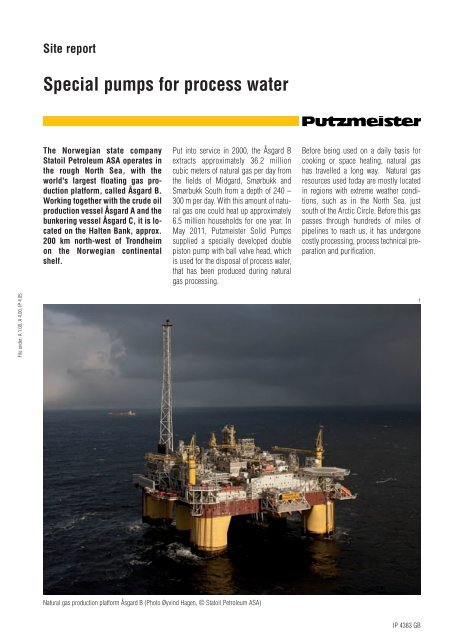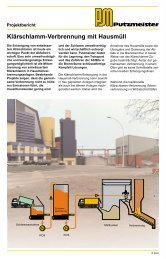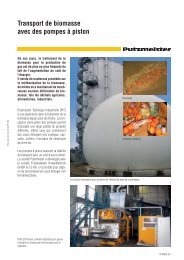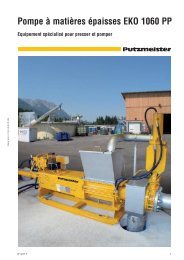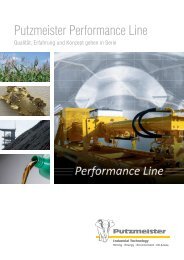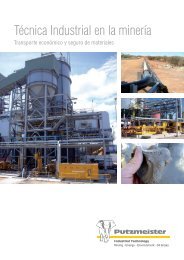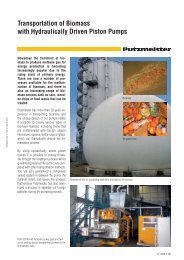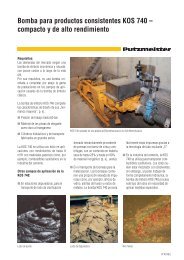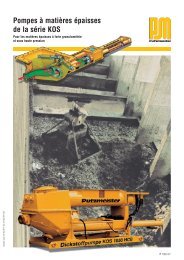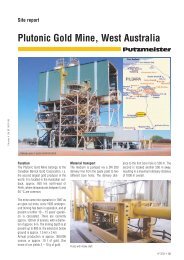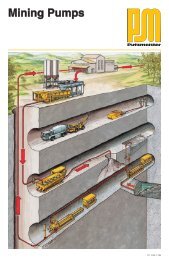English - Putzmeister Solid Pumps
English - Putzmeister Solid Pumps
English - Putzmeister Solid Pumps
Create successful ePaper yourself
Turn your PDF publications into a flip-book with our unique Google optimized e-Paper software.
Site report<br />
Special pumps for process water<br />
The Norwegian state company<br />
Statoil Petroleum ASA operates in<br />
the rough North Sea, with the<br />
world's largest floating gas production<br />
platform, called Åsgard B.<br />
Working together with the crude oil<br />
production vessel Åsgard A and the<br />
bunkering vessel Åsgard C, it is lo -<br />
ca ted on the Halten Bank, approx.<br />
200 km north-west of Trondheim<br />
on the Norwegian continental<br />
shelf.<br />
Put into service in 2000, the Åsgard B<br />
extracts approximately 36.2 million<br />
cubic meters of natural gas per day from<br />
the fields of Midgard, Smørbukk and<br />
Smørbukk South from a depth of 240 –<br />
300 m per day. With this amount of natural<br />
gas one could heat up approximately<br />
6.5 million households for one year. In<br />
May 2011, <strong>Putzmeister</strong> <strong>Solid</strong> <strong>Pumps</strong><br />
supplied a specially developed double<br />
piston pump with ball valve head, which<br />
is used for the disposal of process water,<br />
that has been produced during natural<br />
gas processing.<br />
Before being used on a daily basis for<br />
cooking or space heating, natural gas<br />
has travelled a long way. Natural gas<br />
resources used today are mostly located<br />
in regions with extreme weather condi -<br />
tions, such as in the North Sea, just<br />
south of the Arctic Circle. Before this gas<br />
passes through hundreds of miles of<br />
pipelines to reach us, it has undergone<br />
costly processing, process technical preparation<br />
and purification.<br />
File under: A 1.00, A 4.00, IP 4.05<br />
1<br />
Natural gas production platform Åsgard B (Photo Øyvind Hagen, © Statoil Petroleum ASA)<br />
IP 4383 GB
During this process, health and environmentally<br />
hazardous substances are<br />
released and must be disposed of, with -<br />
out exposing humans, animals or the<br />
environment to risks. Drip water –<br />
so-called process water is such a substance.<br />
Gas platform workers call this a<br />
"cocktail"; a mixture containing salt<br />
water, petroleum residues, tars and a<br />
series of hydrocarbon compounds,<br />
which poses several challenges for process<br />
and plant engineering.<br />
In the past this production residue was<br />
disposed of with much effort and at high<br />
cost. Today, economic aspects demand<br />
an environmentally friendly and costefficient<br />
waste disposal. Currently, the<br />
drip water is pumped back to the treatment<br />
process with piston pumps via an<br />
elaborate network of pipes and valves.<br />
The gaseous substances are separated<br />
from liquids by disposition and separa -<br />
tion devices and processed separately or<br />
disposed of.<br />
The challenge lies precisely in this specific<br />
pumping process. While the requir -<br />
ed output of 24 m³ per hour, at a pump<br />
pressure of up to 87 bar is a solvable<br />
technological challenge, the pumps currently<br />
in use suffer from enormous wear<br />
and tear. This is caused by the various<br />
types of foreign objects, for example,<br />
silicate-containing sand. The wear caus -<br />
ed by foreign bodies leads to frequent<br />
failure of the pumps, which causes high<br />
maintenance expenses each month and,<br />
in worst cases, a loss in production.<br />
Development and manufacturing<br />
Due to the very specific requirements in<br />
terms of mechanical, electrical and<br />
hydraulic design it took two years of<br />
development and manufacturing before<br />
the pump and the hydraulic drive unit<br />
could be delivered. This two-year process<br />
has been successfully completed<br />
with our customer Statoil and the Nor -<br />
wegian engineering company.<br />
The following requirements are parti cu -<br />
larly noteworthy:<br />
Dangerous substances need comp -<br />
lete shielding from the environment.<br />
This is ensured by the pump’s closed<br />
water tank.<br />
In order to optimise the resistance<br />
behaviour of the pump to the abra -<br />
sive wear and the thermal and<br />
mechanical stress, the pump head<br />
was made of chrome, duplex, steel<br />
and Viton piston collars and a hard-<br />
chromed conveying cylinder. Fur thermore,<br />
the entire steel structure is<br />
protected from the salty air by a<br />
special coating.<br />
Limited available space on the production<br />
platform necessitates a high -<br />
ly compact design, which must also<br />
be suitable for transport.<br />
The potentially explosive atmosphere<br />
on board requires all electrical components<br />
to be in compliance with<br />
ATEX guidelines.<br />
Finally, to support the technical process,<br />
a virtually pulsation-free pumping<br />
is necessary. This requirement<br />
is achieved using the PCF method<br />
(pressure constant flow ® ) developed<br />
by <strong>Putzmeister</strong>.<br />
The compliance with customer specifications<br />
and specific offshore provisions,<br />
e.g. the NORSOK Standards<br />
which state explicit requirements for<br />
design, fabrication and materials<br />
could be demonstrated in the presence<br />
of the customer during the<br />
acceptance test bench run.<br />
The Castle of Gods Åsgard<br />
In Norse mythology, the castle Åsgard is described as the abode of the gods<br />
of the Aesir.<br />
It is located in the branches of the world ash Yggdrasil above Midgard, the<br />
realm of men and Utgard, the realm of giants and trolls.<br />
2<br />
IP 4383 GB
<strong>Putzmeister</strong> PCF -Control ®<br />
<strong>Putzmeister</strong> <strong>Solid</strong> <strong>Pumps</strong> now offers PCF<br />
control as an option for virtually all pump<br />
valves. This is used when, for example, a<br />
process requires a a low-pulsation material<br />
flow, or when a reduction in noise is<br />
desired.<br />
P [bar]<br />
Q [m 3 /h]<br />
2<br />
Moreover, the service life of plant components<br />
and pipes can be significantly<br />
extended due to lower pressure surges<br />
and the resulting reduction in mechanical<br />
stress. Technically, the low pulsation<br />
conveyance is guaranteed by two independently<br />
driven hydraulic cylinders<br />
which are synchronised so that pressure<br />
drops and pressure peaks optimally<br />
adjust themselves. The result can be<br />
seen in Fig.1, a virtually pulse-free pressure<br />
history.<br />
Low pulsation production with PCF -control<br />
t [sec]<br />
3<br />
Hydraulic power pack HA 90 S<br />
Double piston pump with<br />
ball valve head KOV 1075<br />
max. capacity<br />
24 m³/h at 87 bar<br />
pump head out of<br />
Chrom-Duplex Steel<br />
2 input and 2 output ball valves<br />
2 separate hydraulic driven<br />
delivery cylinders for a less pulsa -<br />
tion with the control system PCF<br />
pump in ATEX design<br />
automatically lubrication of the<br />
piston<br />
over pressure dense water tank<br />
sound absorbing elements for<br />
lower noise emission<br />
1 main drive E-motor 90 kW<br />
1 E-motor for cooling system<br />
2 hydraulic pumps for the separate<br />
drive of the 2 pistons of the<br />
KOV1075 pump<br />
power pack in ATEX design<br />
base frame and installations in<br />
stainless steel<br />
sound absorbing elements for<br />
lower noise emission<br />
very compact construction<br />
4<br />
IP 4383 GB<br />
3
Specially trained service<br />
personnel<br />
5<br />
In order to ensure a swift and reliable<br />
start-up and be well prepared for<br />
assignments, <strong>Putzmeister</strong> <strong>Solid</strong> <strong>Pumps</strong><br />
has its own trained staff available, which<br />
has undergone safety and survival training<br />
lasting several days. The training<br />
included a simulated helicopter crash, in<br />
Norway in accordance with the offshore<br />
safety regulations.<br />
Simulator for helicopter emergency ditching<br />
Like a rock in the stormy North<br />
Sea – Åsgard B in figures<br />
Commissioned: Autumn 2000<br />
Size (L x W):<br />
114 m x 90 m<br />
Deck area: 10.260 m²<br />
Total weight:<br />
approx. 47.000 t<br />
Weight of superstructures: approx. 28.000 t<br />
Weight of floating objects: approx. 19.000 t<br />
Construction & development costs:<br />
1 Mrd. US$<br />
Operator:<br />
Statoil<br />
Owner: Petoro 35,69 %<br />
Statoil 34,57 %<br />
EniNorge 14,82 %<br />
Total E&P Norge 7,68 %<br />
ExxonMobil 7,24 %<br />
Natural gas production capacity: 36,2 m³ / d<br />
Condensate :<br />
94 T Barrel*/ d<br />
Operating team / crew: ca. 40<br />
Crew cabins: 120<br />
Designed according the<br />
international standards and<br />
special oil, gas, ship and<br />
offshore standards as:<br />
CE<br />
CEN<br />
Atex proofed<br />
ISO<br />
EN<br />
NORSOK<br />
DNV<br />
NOFO<br />
IMO<br />
API<br />
ASME<br />
ANSI<br />
CSA<br />
UL<br />
GOST<br />
Quality Assurance ISO 9001<br />
Registered company member at<br />
German Project Management<br />
Assosiation GPM and World Wide<br />
Experienced Project Manager<br />
Trained service staff with basic<br />
safety an emergency training –<br />
OLF / NSOC-D / OPITO / NOGEPA<br />
*1 Barrel = approx. 159 Liter<br />
Source: © Statoil Petroleum ASA<br />
Registered at Achilles ®<br />
www.achilles.no<br />
Member of the <strong>Putzmeister</strong> Group<br />
www.pm<strong>Solid</strong>.com<br />
Right to make technical amendments reserved<br />
© by <strong>Putzmeister</strong> <strong>Solid</strong> <strong>Pumps</strong> GmbH 2011<br />
All rights reserved<br />
Printed in Germany<br />
(11108SC)<br />
<strong>Putzmeister</strong> <strong>Solid</strong> <strong>Pumps</strong> GmbH<br />
Max-Eyth-Straße 10 · 72631 Aichtal/Germany<br />
P.O.Box 2152 · 72629 Aichtal/Germany<br />
Tel. +49 7127 599 500 · Fax +49 7127 599 988<br />
psp@pmw.de · www.putzmeister-solid-pumps.com<br />
4<br />
IP 4383 GB


